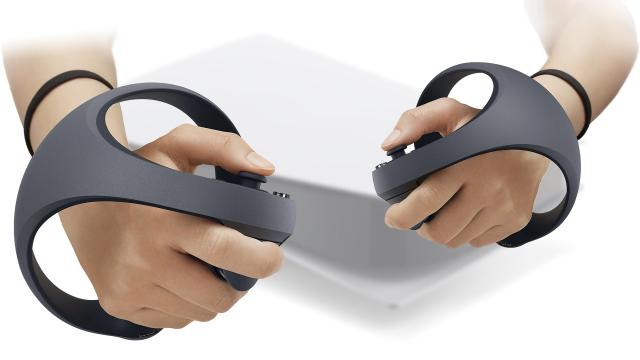Sony’s next-generation virtual reality hardware for PlayStation 5 will include a number of fancy features and even some forward-thinking technologies that are not yet available on popular consumer VR headsets, according to a report on UploadVR.
Citing “reliable sources,” UploadVR reports that the next PlayStation VR headset will feature eye tracking and foveated rendering, haptic feedback, inside-out controller tracking, an IPD adjustment dial, and a per-eye resolution of 2000 x 2040 pixels (4000 x 2080 total).
Eye Tracking and Foveated Rendering
So, what’s all that jargon mean? Let’s start with eye tracking, which will let the headset know exactly what you’re looking at in a scene. Developers could use this as a form of input, or to make your avatar’s gaze more lifelike to other players in games like VR Chat. (Along similar lines, the HTC VIVE PC headset has a face-tracking accessory that lets your facial expressions translate into VR. No word on if Sony’s next is planning to include any face-tracking capabilities.)
Eye tracking also opens the door to a long-hyped graphical technique called foveated rendering. Basically, this would let the headset to devote extra GPU power to wherever you’re currently looking, and expend considerably less GPU resources on areas in your peripheral vision. This could conceivably allow for more detailed scenes to be rendered with the same amount of GPU power, though I don’t think we’ve seen this proven out in any mainstream commercial VR product yet.
The Oculus Quest and Quest 2 currently support a more basic technique called “fixed foveated rendering,” which lets a developer activate foveated rendering manually and without the insight gleaned from eye tracking. This increases performance, but the drawback is your gaze is free to wander over to the parts of the screen that are now low-res, because the VR system can’t tell you’re sneakin’ a peek at its ugly bits. The new PlayStation VR headset will know where you’re looking and be able to adjust the resolution so it always looks good.
Resolution and IPD Adjustment
Speaking of graphics, the new Sony headset’s suggested per-eye resolution of 2000 x 2040 pixels is just slightly north of 4K, and also slightly higher than Oculus Quest 2’s 1832 x 1920 per eye. At that res, the Quest 2 is largely free of the “screen door effect” which plagued earlier VR headsets, so that’s great news for the potential PlayStation device. The Quest 2 also has a maximum refresh rate of 120Hz, but there’s no word, rumour or otherwise, about the forthcoming Sony’s max refresh.
The UploadVR story suggests that the new hardware will feature a lens separation adjustment dial, which is another way of saying you’ll be able to more precisely tell it the distance between the pupils of your eyes. Ensuring a headset matches your interpupillary distance, or IPD, is an important factor in getting a solid, comfortable 3D image. The Oculus Quest 2, as good as it is, has been criticised for only offering three discrete IPD settings instead of a more adjustable dial, as some users’ IPD measurements fall in between those discrete settings.
Inside-Out Tracking
Most earlier consumer VR hardware required special sensors set up around your play area to track the positions of your controllers; this “outside-in” tracking was a huge pain in the butt. Inside-out tracking, such as seen in the Oculus Quest devices, lets the headset itself track where your controllers are via built-in cameras, with no external sensors to worry about. It’s definitely the way to go.
Haptic Feedback
UploadVR’s sources also claim the next-gen Sony headset will feature haptic feedback via a built-in motor, giving developers a new way to help players feel the in-game action. The new motor in the headset will be in addition to the touch-centric features already announced for the next-gen PSVR controllers (pictured up top), including adaptive triggers that can offer resistance (just like on the normal DualSense controller) and the controllers’ own haptic feedback features. Long story short, high-quality rumble is on the menu.
Still Wired, Though
If you’ve been reading this and thinking, “This compares very favourably with the Oculus Quest 2” you’re not alone, because it sure does. Perhaps the one major place Sony’s forthcoming PlayStation VR headset will come up short in that comparison is that it’s still going to be wired. A single USB-C cable will run between your headset and the PlayStation 5. That’s an improvement on the current PlayStation VR’s unwieldy, multi-wire breakout box, but still a far way from the elegance and freedom of a wireless headset like Quest 2.
Aside from the wired thing, the purported details in these leaks are pretty encouraging, and suggest that Sony remains serious when it says, “our commitment to virtual reality as a medium for games is stronger than ever.” While this next-gen PlayStation VR won’t be launching this year, here’s hoping PlayStation 5 players can eventually enjoy some top-tier VR alongside their Oculus Quest 2 and PC VR brethren.

Leave a Reply